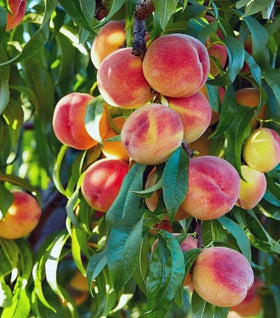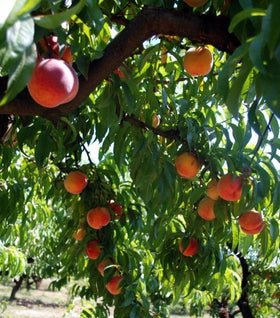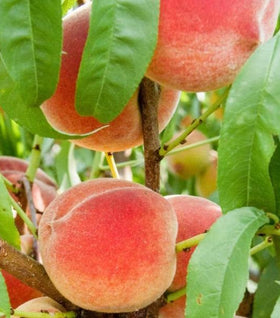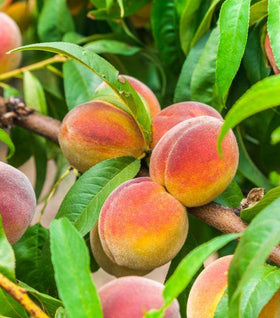Peach Trees for Sale Online
Peaches are so colorful and delicious that it is no suprise it is the second most grown fruit in America, right behind apples. There are many different varieties of peach trees, but there are two main differences between varieties, the first being the color of the flesh. There are white and yellow-fleshed peaches. The white-fleshed varieties tend to be sweeter than their yellow counterparts. Another difference with peach varieties is that some are freestone and some are called clingstone Peaches. Freestone peaches have larger pits that are easier to remove while the clingstone peaches in fact cling to the flesh and are harder to remove.
Freestone peaches tend to ripen over a longer season beginning as early as May in some areas through to October. Clingstones ripen from May to August. Clingstone Peaches are better for baking, canning, and preserving while the Freestones are better for eating fresh.
Deciding Which Variety of Peach Tree to Grow
Most Peach trees offered for sale today are self-pollinating. This means that one tree will produce fruit in your garden without needing to be pollinated by another tree. As with most fruit trees, your tree will grow more fruit when there are two peach trees in the garden.
The second tree can be of the same variety, but by having two different varieties, each tree will be cross-pollinated, and you can enjoy the flavors of different peaches. These two different trees can be planted as far apart as 50 feet, and you'll still get the benefits of cross-pollination.
If you only have space for one tree, The Redhaven Peach Tree is the best choice as it has been proven to produce a large crop without a companion tree. It is the ideal tree for smaller gardens due to its medium size.
Choosing the Best Location for a Peach Tree
When deciding on a location for growing fruit trees, there are two main things to consider: Sun and Soil.
Sun: Peach Trees thrive and produce the most fruit when planted in an area that receives full sun. Full sun is defined as 6 to 8 hours of un-blocked sunlight during the growing season. Sun is vital for the tree to produce good quality fruit.
Full sun also helps to reduce the instance of disease on fruit trees. Fruits that are grown in less than the full sun can develop spots or other types of fungus.
Soil: Peach Trees, as with most fruit trees, will thrive in just about any soil; however, they will not grow in an area that remains wet for extended periods of time. If you live in an area where the soil comprises heavy clay, it is recommended that you amend your soil with locally sourced compost to "lighten" the soil, which will help keep the roots of the tree healthy. Healthy roots are the key to a healthy tree.
If you're not sure of your soil's overall quality, contact your local extension office, and they can help you sample and test your soil.
Planting a Peach Tree
After you've chosen the best location for your Peach Tree, there are a few easy steps to follow for planting your tree. Peach trees can be planted at any time of the year as long as the soil can be worked.
Step 1: Water the Peach Tree thoroughly while it is in the pot. Water until you see the water running out of the bottom of the pot.
Step 2: Dig a hole twice as wide as the pot the tree is growing in. The depth of the hole should be as deep as the root ball, but not deeper. After the tree is planted, you should still be able to see the original nursery soil. Planting the Peach Tree too deep is the leading cause of poor growth and death of newly planted trees.
Step 3: If your existing soil is of poor quality, you should amend the soil with local compost or peat moss at a 50/50 rate. This is also the time to mix in an organic starter fertilizer such as Bio-tone by Espoma.
Step 4: Place the Peach Tree in the prepared hole, careful not to overly disturb the roots. It is ok to fluff the roots if the tree is rootbound. This will cause the tree roots to begin to grow out and down rather than circle the root ball.
Step 5: Begin back-filling with the amended soil in 3 to 4-inch layers being careful to tamp the soil between layers. This will remove air pockets and voids created by larger chunks of soil. Be cautious not to damage the existing roots of the tree during this process.
Step 6: Use the leftover soil to create a 3 to 4-inch rim around the planting hole's edges. This will allow water to pool around the newly planted tree and slowly seep into the root zone. Proper watering is essential to the survival of the tree.
We also recommend mulching the newly planted Peach Tree. This helps prevent the sun from drying out the soil and damage the trunk from mowing equipment such as string-trimmers.
Watering Peach Trees
After you have planted your tree, it should be watered about every 2 to 3 days for the first 4 weeks. After that, begin to cut back on the watering frequency but not the amount of water. When watering, be sure to soak the entire root system. Remember that the root system is usually 18 inches deep on a newly planted tree, and water should soak all the way through the bottom.
Two of the easiest ways to water newly planted trees is to lay the end of the hose at the base of the tree inside the rim and allow it to trickle at the base for 30 to 40 minutes or until you see the water begin to pool.
The second way and our favorite way is to use a Dewitt Dew Right tree watering bag . Install the bag at the base of the tree and fill it with water. Water is allowed to slowly drain from the bag providing the perfect amount of water to the root zone.
Pruning your Peach Trees
Pruning can seem like a daunting task, but you will find it an enjoyable and fulfilling task once you do it the first time. Pruning Peaches Trees should take place during the dormant season (Winter). Pruning stimulates the tree to branch and will make it stronger and more fruitful.
By reducing the branches' length by Pruning, the tree will support a heavy crop of Peaches and not risk the branches breaking under the weight of the crop. The fruits grown on a properly pruned Peach Tree will be larger. Many of the new medium-sized to semi-dwarf Peach trees have shorter branches, meaning that the crop's weight will be less of a problem, and you likely can skip pruning.
Penn State University has published an excellent paper on the Proper Pruning of Peach Trees.
Controlling pests and diseases on Peach Trees
Breeders of Peach trees are continually working to create new disease-resistant Peach varieties. However, Peach Trees will need to be sprayed occasionally to help control pests and diseases. Control is straightforward and, in most cases, can be done organically and with minimal effort.
Bonide Copper Fungicide is an easy to use and safe tool for the fruit growers' toolbox. Copper is a natural way to control most diseases on Peach trees.
Bonide Citrus and Orchard Spray is a good choice for insect pests with the added benefit of controlling some diseases.
Remember, proper pruning is the best disease control for Peach Trees as this allows good airflow within the canopy of the tree.
If your planning to start planting your own orchard at home Garden Goods Direct is your one-stop-shop for fertilizers, insect and disease control products, and various types of fruit trees, including Pear Trees, Citrus Trees, Apple Trees, and many more!





